2013 Peugeot 807 steering
[x] Cancel search: steeringPage 49 of 234

Steering wheel controls
EASE OF USE and COMFORT
3
47
Activation
Press the control downwards.
Activation of the function is
accompanied by a message on the
display.
The automatic windscreen wipers
function must be reactivated
if the
ignition has been switched off for more
than one minute, by pressing the stalk
downwards.
Rear windscreen wiper
Turn the ring to the fi rst
notch. The wiping speed is
inversely proportional to the
speed of the vehicle.
Rear windscreen wash
Turn the ring past the fi rst
notch: the windscreen wash
then the windscreen wiper
operate for a fi xed time.
Good practice
When using an automatic car
wash, switch off the ignition without
setting the alarm.
In winter, it is advisable to wait until the
windscreen is completely clear of ice
before activating the automatic wiping.
In the event of a considerable amount
of snow or ice, switch on the rear
screen demister. Once de-icing is
complete, remove the snow or ice
which has accumulated on the rear
wiper blade. You can now operate the
rear windscreen wiper.
If a tailgate bicycle carrier
is used, deactivate the rear
wiper by going to the display's
confi guration menu.
Deactivation/Switching off
Place the windscreen wipers stalk in
position I
, 1
or 2
. Deactivation of the
function is accompanied by a message
on the display.
In the event of malfunction
of the
automatic windscreen wipers, the
windscreen wipers will operate in
intermittent mode.
Contact a PEUGEOT dealer to have
the system checked.
Automatic wiping - reverse gear
- place the front wipers stalk in a
position other than 0
.
- engage reverse gear.
- the rear wiper operates with
intermittent wiping.
When using an automatic car
wash, switch off the engine.
In winter, it is advisable to wait
until the windscreen is completely
clear of ice before activating the
automatic wiping.
Page 50 of 234
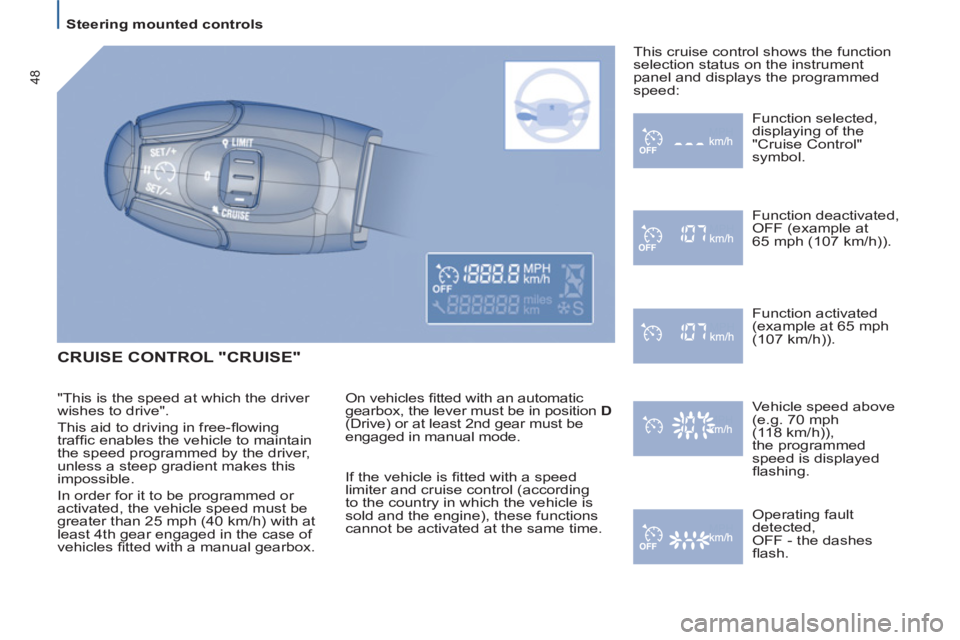
Steering mounted controls
48
CRUISE CONTROL "CRUISE"
On vehicles fi tted with an automatic
gearbox, the lever must be in position D
(Drive) or at least 2nd gear must be
engaged in manual mode. Function selected,
displaying of the
"Cruise Control"
symbol.
Function deactivated,
OFF (example at
65 mph (107 km/h)).
Function activated
(example at 65 mph
(107 km/h)).
Vehicle speed above
(e.g. 70 mph
(118 km/h)),
the programmed
speed is displayed
fl ashing.
Operating fault
detected,
OFF - the dashes
fl ash. This cruise control shows the function
selection status on the instrument
panel and displays the programmed
speed:
"This is the speed at which the driver
wishes to drive".
This aid to driving in free-fl owing
traffi c enables the vehicle to maintain
the speed programmed by the driver,
unless a steep gradient makes this
impossible.
In order for it to be programmed or
activated, the vehicle speed must be
greater than 25 mph (40 km/h) with at
least 4th gear engaged in the case of
vehicles fi tted with a manual gearbox. If the vehicle is fi tted with a speed
limiter and cruise control (according
to the country in which the vehicle is
sold and the engine), these functions
cannot be activated at the same time.
Page 51 of 234
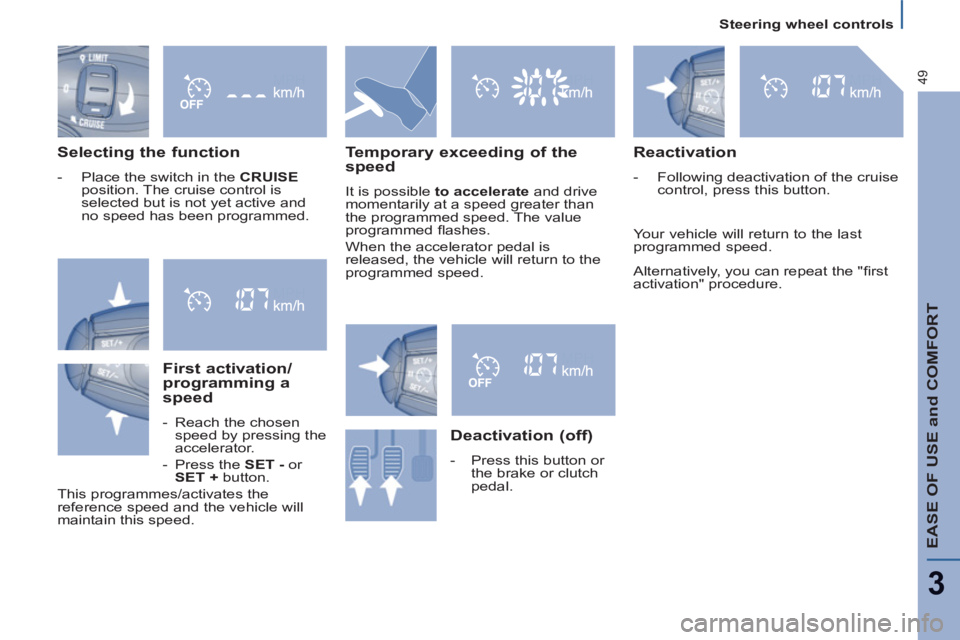
Steering wheel controls
EASE OF USE and COMFORT
3
49
Selecting the function
- Place the switch in the CRUISE
position. The cruise control is
selected but is not yet active and
no speed has been programmed.
First activation/
programming a
speed
- Reach the chosen
speed by pressing the
accelerator.
- Press the SET -
or
SET +
button.
This programmes/activates the
reference speed and the vehicle will
maintain this speed.
Temporary exceeding of the
speed
It is possible to accelerate
and drive
momentarily at a speed greater than
the programmed speed. The value
programmed fl ashes.
When the accelerator pedal is
released, the vehicle will return to the
programmed speed.
Reactivation
- Following deactivation of the cruise
control, press this button.
Your vehicle will return to the last
programmed speed.
Alternatively, you can repeat the "fi rst
activation" procedure.
Deactivation (off)
- Press this button or
the brake or clutch
pedal.
Page 52 of 234
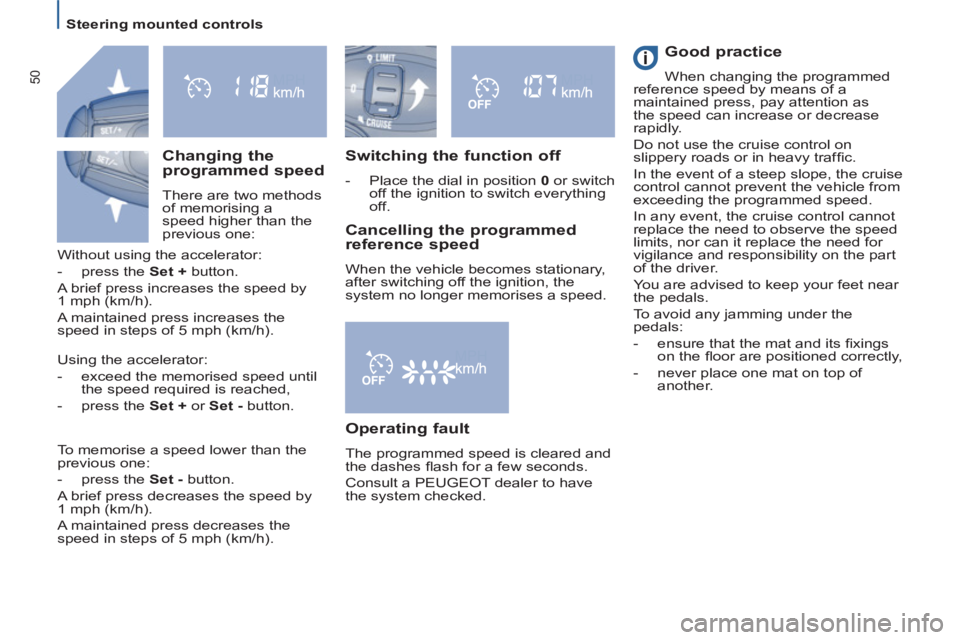
Steering mounted controls
50
Switching the function off
- Place the dial in position 0
or switch
off the ignition to switch everything
off.
Good practice
When changing the programmed
reference speed by means of a
maintained press, pay attention as
the speed can increase or decrease
rapidly.
Do not use the cruise control on
slippery roads or in heavy traffi c.
In the event of a steep slope, the cruise
control cannot prevent the vehicle from
exceeding the programmed speed.
In any event, the cruise control cannot
replace the need to observe the speed
limits, nor can it replace the need for
vigilance and responsibility on the part
of the driver.
You are advised to keep your feet near
the pedals.
To avoid any jamming under the
pedals:
- ensure that the mat and its fi xings
on the fl oor are positioned correctly,
- never place one mat on top of
another.
Changing the
programmed speed
There are two methods
of memorising a
speed higher than the
previous one:
Without using the accelerator:
- press the Set +
button.
A brief press increases the speed by
1 mph (km/h).
A maintained press increases the
speed in steps of 5 mph (km/h).
Operating fault
The programmed speed is cleared and
the dashes fl ash for a few seconds.
Consult a PEUGEOT dealer to have
the system checked. Using the accelerator:
- exceed the memorised speed until
the speed required is reached,
- press the Set +
or Set -
button.
To memorise a speed lower than the
previous one:
- press the Set -
button.
A brief press decreases the speed by
1 mph (km/h).
A maintained press decreases the
speed in steps of 5 mph (km/h).
Cancelling the programmed
reference speed
When the vehicle becomes stationary,
after switching off the ignition, the
system no longer memorises a speed.
Page 53 of 234
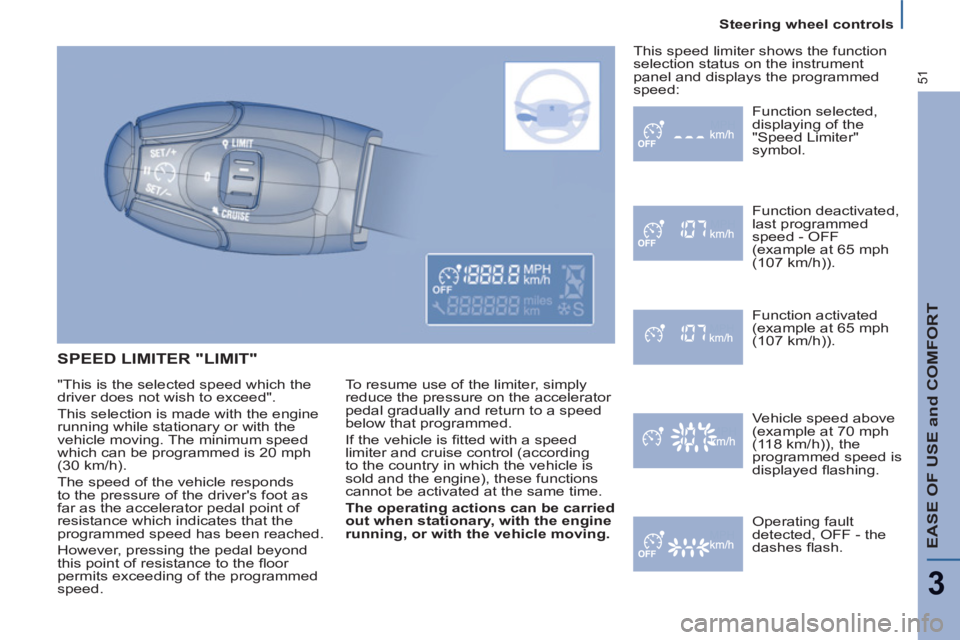
Steering wheel controls
EASE OF USE and COMFORT
3
51
SPEED LIMITER "LIMIT"
To resume use of the limiter, simply
reduce the pressure on the accelerator
pedal gradually and return to a speed
below that programmed.
If the vehicle is fi tted with a speed
limiter and cruise control (according
to the country in which the vehicle is
sold and the engine), these functions
cannot be activated at the same time
.
The operating actions can be carried
out when stationary, with the engine
running, or with the vehicle moving.
Function selected,
displaying of the
"Speed Limiter"
symbol.
Function deactivated,
last programmed
speed - OFF
(example at 65 mph
(107 km/h)).
Function activated
(example at 65 mph
(107 km/h)).
Vehicle speed above
(example at 70 mph
(118 km/h)), the
programmed speed is
displayed fl ashing.
Operating fault
detected,
OFF - the
dashes fl ash. This speed limiter shows the function
selection status on the instrument
panel and displays the programmed
speed:
"This is the selected speed which the
driver does not wish to exceed".
This selection is made with the engine
running while stationary or with the
vehicle moving. The minimum speed
which can be programmed is 20 mph
(30 km/h).
The speed of the vehicle responds
to the pressure of the driver's foot as
far as the accelerator pedal point of
resistance which indicates that the
programmed speed has been reached.
However, pressing the pedal beyond
this point of resistance to the fl oor
permits exceeding of the programmed
speed.
Page 54 of 234
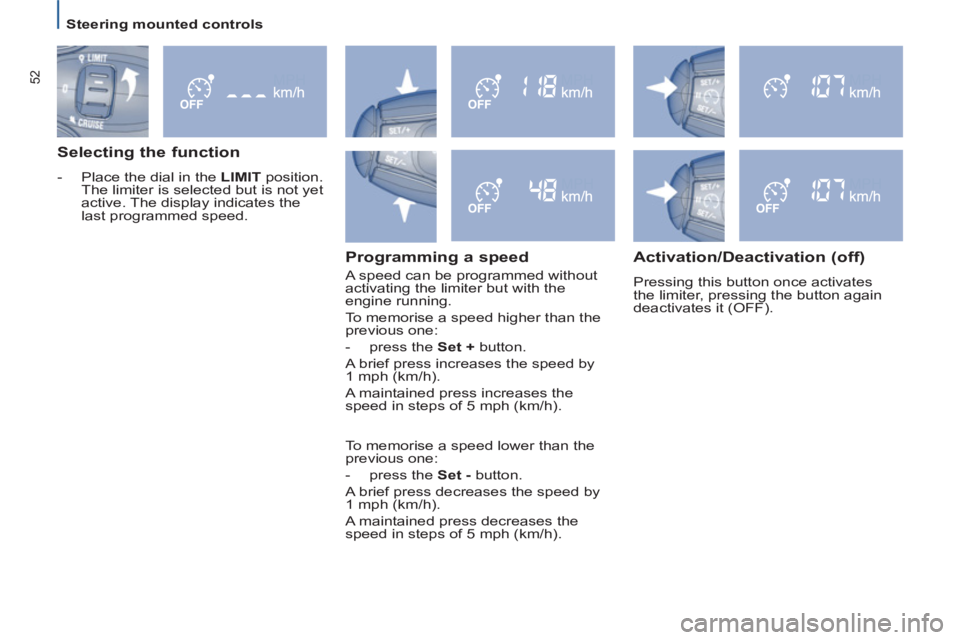
Steering mounted controls
52
Selecting the function
- Place the dial in the LIMIT
position.
The limiter is selected but is not yet
active. The display indicates the
last programmed speed.
Programming a speed
A speed can be programmed without
activating the limiter but with the
engine running.
To memorise a speed higher than the
previous one:
- press the Set +
button.
A brief press increases the speed by
1 mph (km/h).
A maintained press increases the
speed in steps of 5 mph (km/h).
Activation/Deactivation (off)
Pressing this button once activates
the limiter, pressing the button again
deactivates it (OFF).
To memorise a speed lower than the
previous one:
- press the Set -
button.
A brief press decreases the speed by
1 mph (km/h).
A maintained press decreases the
speed in steps of 5 mph (km/h).
Page 55 of 234
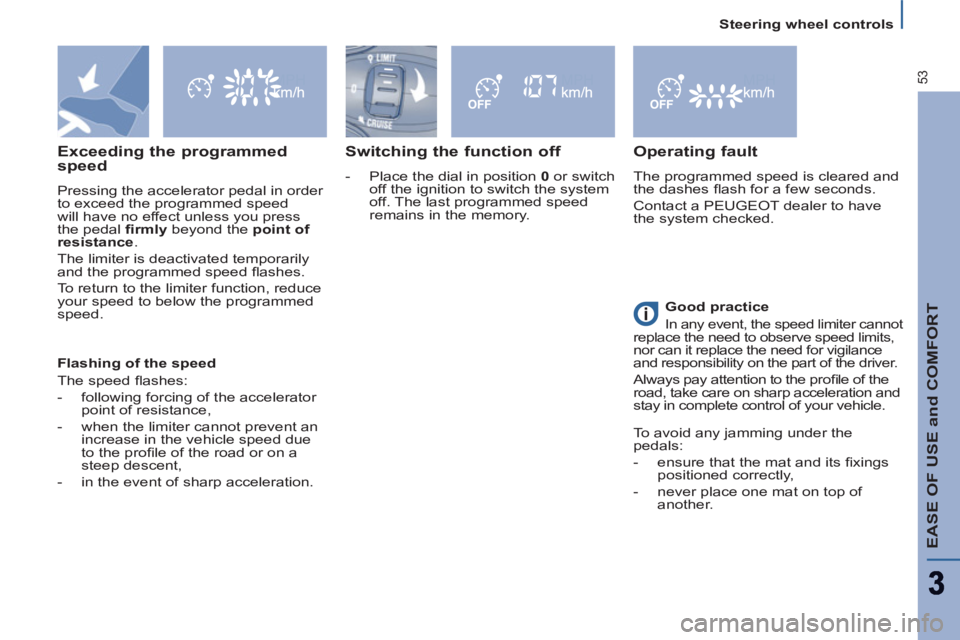
Steering wheel controls
EASE OF USE and COMFORT
53
Switching the function off
- Place the dial in position 0
or switch
off the ignition to switch the system
off. The last programmed speed
remains in the memory.
Exceeding the programmed
speed
Pressing the accelerator pedal in order
to exceed the programmed speed
will have no effect unless you press
the pedal fi rmly
beyond the point of
resistance
.
The limiter is deactivated temporarily
and the programmed speed fl ashes.
To return to the limiter function, reduce
your speed to below the programmed
speed.
Operating fault
The programmed speed is cleared and
the dashes fl ash for a few seconds.
Contact a PEUGEOT dealer to have
the system checked.
Flashing of the speed
The speed fl ashes:
- following forcing of the accelerator
point of resistance,
- when the limiter cannot prevent an
increase in the vehicle speed due
to the profi le of the road or on a
steep descent,
- in the event of sharp acceleration.
Good practice
In any event, the speed limiter cannot
replace the need to observe speed limits,
nor can it replace the need for vigilance
and responsibility on the part of the driver.
Always pay attention to the profi le of the
road, take care on sharp acceleration and
stay in complete control of your vehicle.
To avoid any jamming under the
pedals:
- ensure that the mat and its fi xings
positioned correctly,
- never place one mat on top of
another.
Page 64 of 234
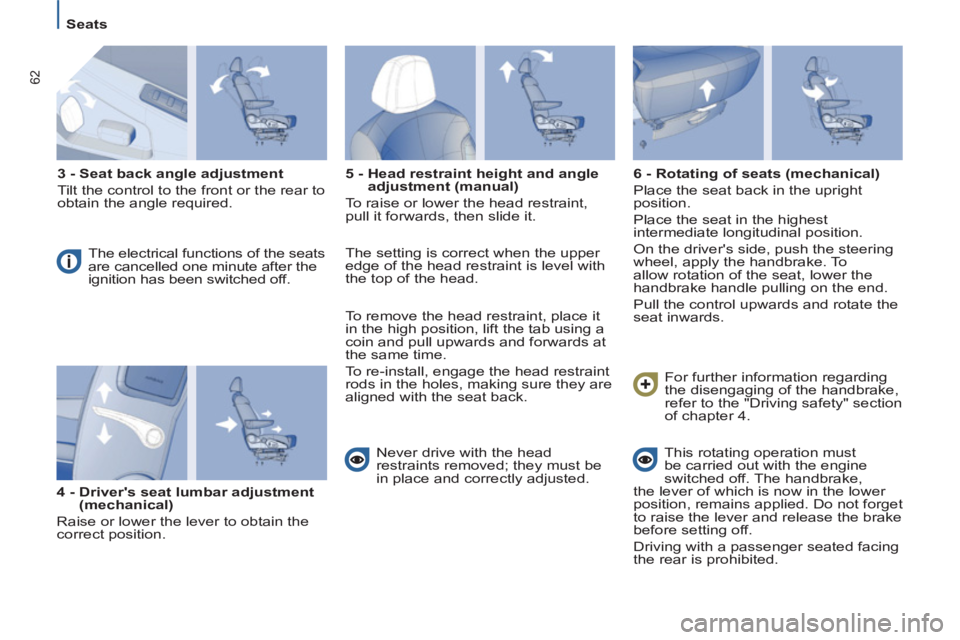
62
Seats
3 - Seat back angle adjustment
Tilt the control to the front or the rear to
obtain the angle required.
The electrical functions of the seats
are cancelled one minute after the
ignition has been switched off.
4 - Driver's seat lumbar adjustment
(mechanical)
Raise or lower the lever to obtain the
correct position.
5 - Head restraint height and angle
adjustment (manual)
To raise or lower the head restraint,
pull it forwards, then slide it.
Never drive with the head
restraints removed; they must be
in place and correctly adjusted.
6 - Rotating of seats (mechanical)
Place the seat back in the upright
position.
Place the seat in the highest
intermediate longitudinal position.
On the driver's side, push the steering
wheel, apply the handbrake. To
allow rotation of the seat, lower the
handbrake handle pulling on the end.
Pull the control upwards and rotate the
seat inwards.
This rotating operation must
be carried out with the engine
switched off. The handbrake,
the lever of which is now in the lower
position, remains applied. Do not forget
to raise the lever and release the brake
before setting off.
Driving with a passenger seated facing
the rear is prohibited. For further information regarding
the disengaging of the handbrake,
refer to the "Driving safety" section
of chapter 4. The setting is correct when the upper
edge of the head restraint is level with
the top of the head.
To remove the head restraint, place it
in the high position, lift the tab using a
coin and pull upwards and forwards at
the same time.
To re-install, engage the head restraint
rods in the holes, making sure they are
aligned with the seat back.